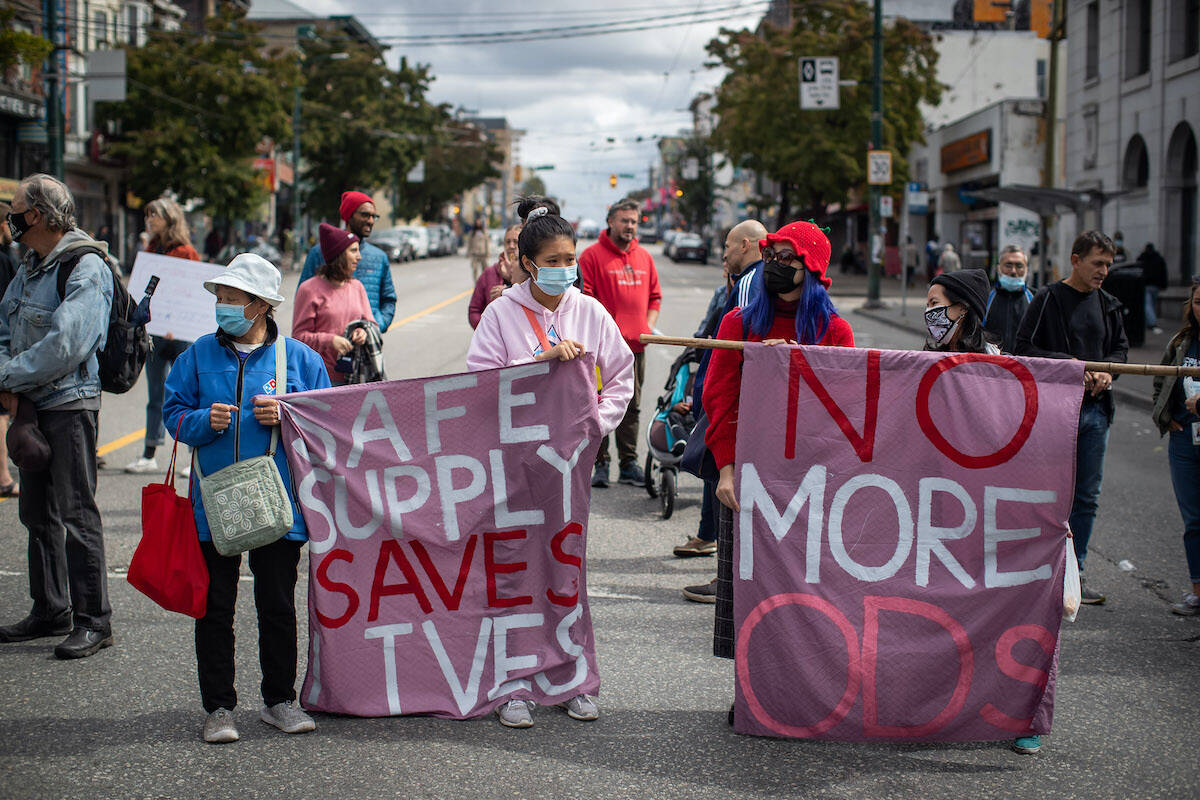An estimated 2,224 British Columbians died from toxic drug poisonings in 2021, marking the worst year in the province’s history in the ongoing overdose crisis.
That’s an average of six deaths per day.
Five years since then-provincial health officer Dr. Perry Kendall declared B.C.’s first public health emergency in 2016, many trends have remained the same: A majority of the deaths (83 per cent) occurred indoors, and 71 per cent of those dying were aged 30 to 59 and predominately men.
No deaths were reported at supervised consumption or drug overdose prevention sites.
Vancouver, Surrey and Victoria continued to see the highest number of illicit drug toxicity deaths, at 524, 281 and 126 fatalities, respectively. Meanwhile, all corners of the province have been impacted with Northern Health seeing death rates of 48 per 100,000 people.
In 2020, when the pandemic first wreaked havoc on the world leading to increased toxicity among street-level drugs, there were 1,767 recorded deaths.
Toxicological testing by the B.C. Coroners Service continues to underscore the toxicity of drugs being sold illicitly, data shows. Fentanyl was detected in 83 per cent of samples tested in 2021, while carfentanil, an opioid used to tranquilize large animals, was present in 187 results, almost triple the number recorded in 2020.
ALSO READ: B.C. street drugs poisoned with benzos could lead to ‘catastrophic’ overdoses
Fifty per cent of samples in December tested positive for the benzodiazepine called etizolam, up from 15 per cent in July.
Benzodiazepines have created significant challenges for frontline workers and first responders, as overdoses caused by these drugs cannot be reversed by naloxone as opioid overdoses can.
READ MORE: B.C. applies to decriminalize personal possession of illicit drugs amid opioid crisis
In a news conference Wednesday, chief coroner Lisa Lapointe called for decision-makers at all levels of government to respond with urgency – noting the speedy reaction officials have had in order to save lives due to the COVID-19 disease.
“Drug toxicity is now second only to cancers in B.C. for potential years of life lost,” she said.
“We cannot simply hope that things will improve. It is long past time to end the chaos and devastation in our communities resulting from the flourishing illicit drug market, and to ensure, on an urgent basis, access across the province to a safe, reliable regulated drug supply.”
In 2011, when overdose deaths were first recorded, 295 lives were lost. Fatalities from illicit drugs started to spike in two-fold in 2015 to 2017.
ALSO READ: ‘Benzos’ and fentanyl a deadly cocktail causing a growing concern on B.C. streets
In the past 10 years, 10,817 people have died.
In a seperate news conference Wednesday, Addictions Minister Sheila Malcolmson said that B.C. is fighting two public health emergencies: toxic drugs and the pandemic.
“From the COVID-19 pandemic, the toxic drug crises, to heat, floods, and fires, we have never asked as much from our health-care system, front-line health-care workers and B.C. families. And yet, we need to do more.”
Malcolmson pointed to efforts to decriminilze simple posession of illicit drugs, which is being reviewed by Health Canada.
The Drug User Liberation Front and the Vancouver Area Network of Drug Users took to the streets of Vancouver that afternoon to hand out heroin, cocaine and meth which had first been tested for fentanyl and deadly additives.
Meanwhile, advocates have said that the government needs to go further than decriminilization and focus on growing access to a safe supply for drug users as a key step in harm reduction efforts.
@ashwadhwani
ashley.wadhwani@bpdigital.ca
Like us on Facebook and follow us on Twitter.

